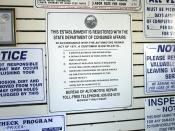Performance Measurement
Our performance evaluation will be designed to assess whether our combined activities:
have been effective in achieving our statutory objectives; and
Comply with the principles of good regulation.
Examples of indicators to measure our performance for each of the objectives and principles are given below. This represents our early thinking and will be developed as the project progresses. Because of the inter-relationship between the objectives, many of these indicators apply to more than one objective. We will also set success criteria for our project and evaluate performance to learn lessons for the future.
Assessing the achievement of our objectives and the impact of our regulatory activities is a complex exercise. We will develop 'clusters' of performance indicators which, taken together, will give an overall picture. Some of these indicators will need careful interpretation. For example, an increase in the level of complaints by consumers may be a negative long-term indicator in relation to the consumer protection objective.
But a short-term increase may be positive if it results from a consumer awareness programmer designed to inform consumers of their rights, or from more comprehensive recording of complaints by firms.
Our aim will be to assess the outcome of an action rather than the input. Although outcome measures are more difficult to develop, they are more informative and will help users understand better the impact of our actions. We expect that most performance measures will eventually have some form of target attached.
We will aim to use third-party information where available to measure our performance. This will reduce the cost and provide an independent view. For example, international surveys, such as that produced by the World Economic Forum, contain several measures that are useful indications of the US's position relative to other financial markets (e.g. comparative measures for the ease...



Almost good
The result of your essay is mediocre..!! You should include references and critical thinking..!!
0 out of 0 people found this comment useful.